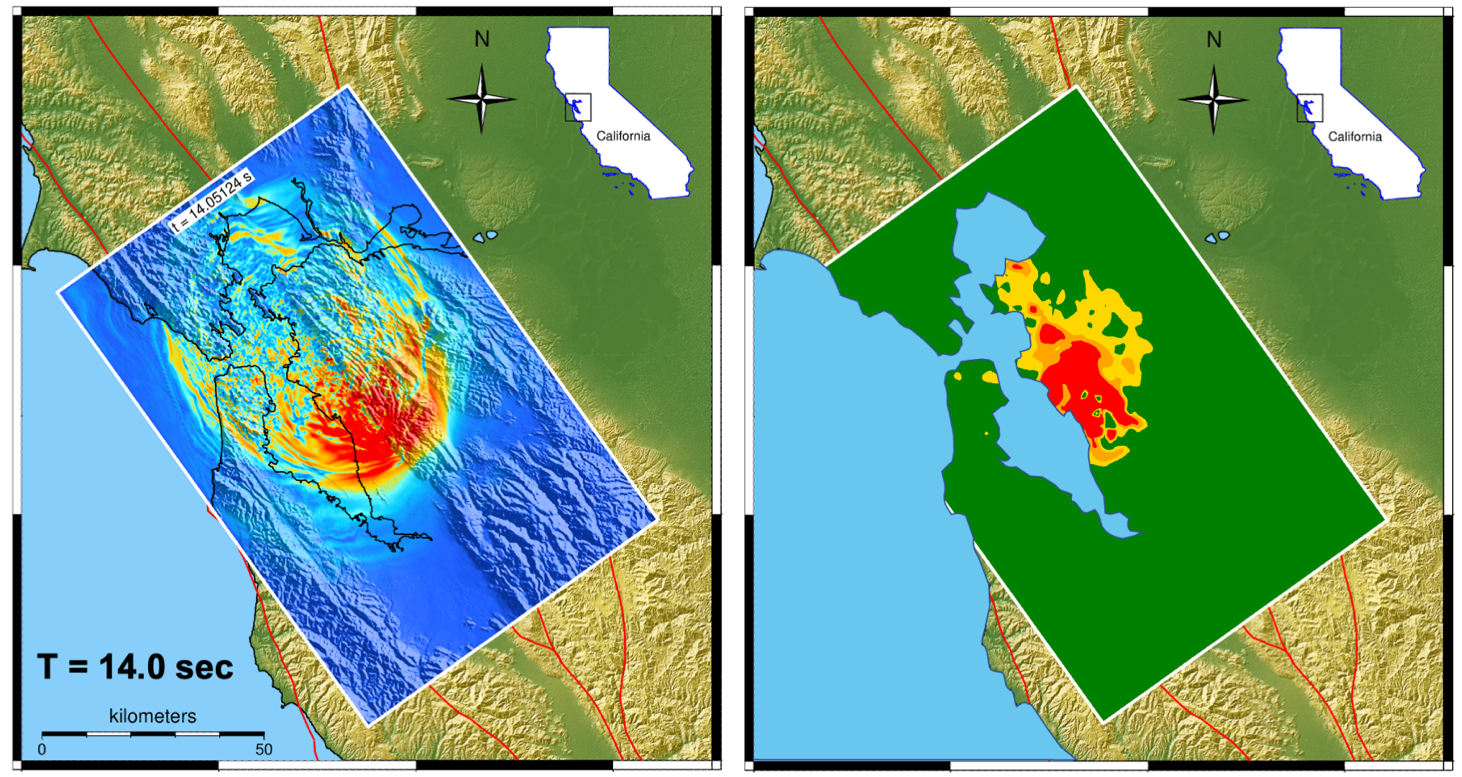
 |
| November 2023 Volume 12 Issue 4 |

Over the past five years an integrated, multidisciplinary team from Lawrence Berkeley National Laboratory and Lawrence Livermore National Laboratory have developed the EarthQuake SIMulation (EQSIM) framework for fault-to-structure, regional-scale earthquake simulations under the U.S. DOE Exascale Computing Project. The EQSIM application development project is focused on creating an unprecedented computational tool set and workflow for earthquake hazard and risk assessment. Starting with a set of existing codes - SW4 (the fourth-order, 3D seismic wave propagation model developed at LLNL), NEVADA (a nonlinear, finite displacement program for building earthquake response), and OPENSEES (a nonlinear finite-element program for coupled soil-structure interaction) - EQSIM has created an end-to-end capability to simulate from the initiation of fault rupture to site-specific ground motions and ultimately to infrastructure response. EQSIM’s ultimate goal is to remove computational limitations as a barrier to simulation-based scientific exploration, understanding earthquake phenomenology, and practical earthquake hazard and risk assessments. To achieve EQSIM goals, the SW4 code has been substantially advanced ... [full article]
Dear Community,
The summer workshop season wrapped-up at HQ with our newest training offering, Crafting Quality Research Software and Navigating Publication in Software Journals. After over 20 years of championing open source software, it is heartening to see the interest from the community in sharing software. This includes a big welcome to the latest addition - Geodyamic World Builder (see article below) whose community is led by Menno Fraters. We hope this workshop series continues to foster open science and code communities. If you missed this workshop, use the link above to access recordings from Part I.
Part II of our workshop on software publishing was collocated with the SCEC Annual Meeting. The recent announcement of funding for two new centers in geohazards [NSF] energized conversations. Both CRESCENT and the expanded SCEC along with the SZ4D initiative provide opportunities for our community to grow and collaborate on the development of open source software and training for the next generation of scientists entrusted to improve society's resilience to natural hazards.
Did you catch that ASPECT has a new name? ASPECT, one of CIG's flagship software packages, is now the Advanced Solver for Planetary Evolution, Convection, and Tectonics. In the last several years, its community has grown in new directions. Originally established as a modern open source code in mantle convection, the community of user-developers has leveraged ASPECT's unique architecture and contributed code to study problems in lithospheric dynamics and tectonics on other celestial bodies than the Earth such as the moon, Mars or Io. I am excited to see what new directions are in store with the growing recognition of the importance of feedbacks between geodynamic procesess, such sediment transport, ice thickness, and sea level, especially under today's changing climate.
Looking forward to seeing you in San Francisco and catching up on your science. Don't forget to send us your presentation so community members can learn about your research [presentations].
Lorraine Hwang & Bruce Buffett, co-Directors
NEW to the CIG code community, the Geodynamic World Builder (GWB) is an open source code library used to set up initial conditions for computational geodynamic models and/or visualize complex 3D tectonic settings in both Cartesian and spherical geometries. The inputs for the JSON-style parameter file are not mathematical, but rather a structured nested list describing tectonic features such as a continental, an oceanic or a subducting plate. Each of these tectonic features can be assigned a specific temperature profile or composition label. GWB has been used to build models for ASPECT, ELEFANT, Fieldstone, and C-PRAN. Thanks to Principal Developer, Menno Fraters, University of Florida.
For more information see the GWB website and its extensive online User Manual.
!conda list to see which libraries are installed.
For more information, see ASPECT Jupyter Notebooks.
Have a notebook you are interested in sharing with the community?
Please contact us to discuss creating a new resource
for the community.
The 2023 Elections are now open - 1 seat is open on the Executive Committee and 2 on the Science Steering Committee. We thank Alice Gabriel for her leadership on the EC and SSC members Ebru Bozdag ad Sylvain Barbot for their contributions to the community. Contact your Member Representative for voting. Elections close Monday November 30, 2023. [slate]
CIG Monthly Webinars have a new time Thursdays @noon / 12P PT. The 2024 webinar series will focus on current efforts to understand the relationship between different systems in geosciences. By presenting examples of coupled geodynamics models and the difficulties encountered in coupling them, speakers of this series invite us into exploration and discussions of the science opportunities and challenges in code coupling and multidisciplinary research. See the webinar page and the calendar for more information.
| 2023 | |||
| December 13 | CIG Annual Business Meeting | San Francisco, California | |
| 2024 | |||
| Winter-Spring 2024 | Webinar Series | zoom | |
| June 10-14 | Crustal Deformation Modeling Workshop | Golden, Colorado | |
| Summer | ASPECT Hackathon | tbd | |
| Summer | Rayleigh Hackathon | tbd |